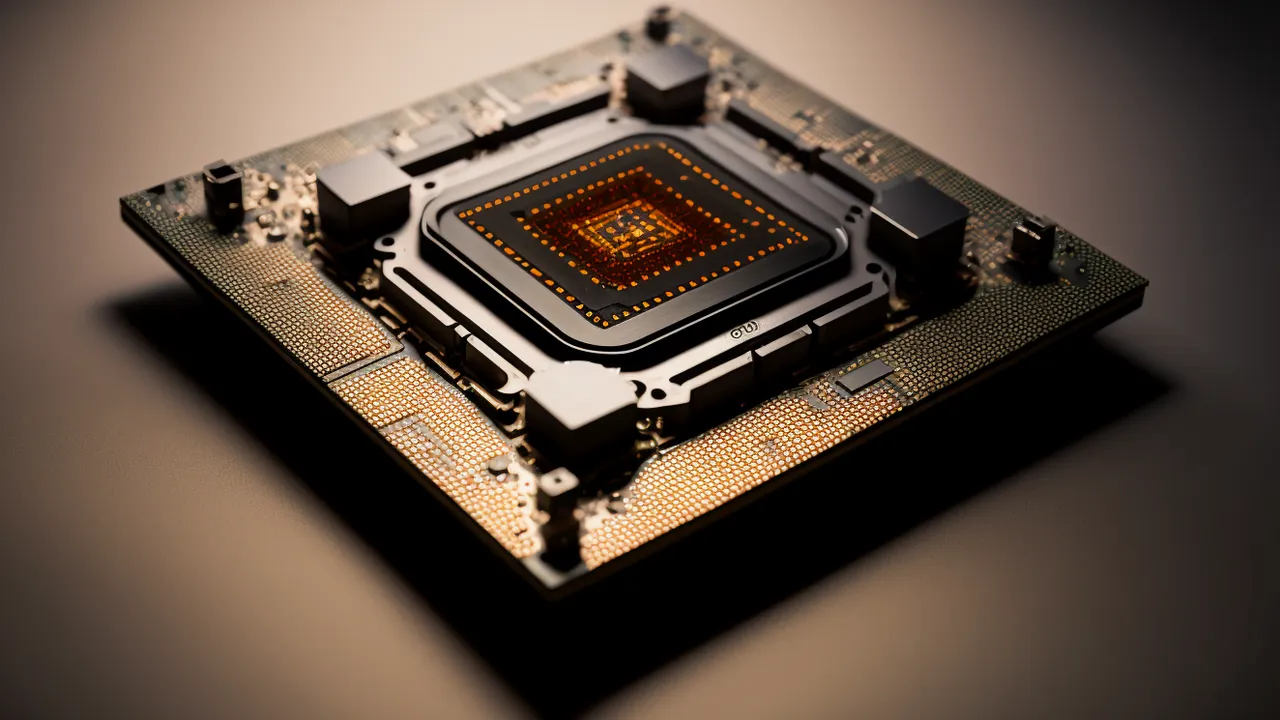AI Hardware: The Latest Developments in AI Processors

Explore the latest developments in AI hardware, including AI processors. This article discusses the different types of AI processors and their performance. Discover the future of AI hardware.
Understanding the Landscape of AI Processors AI Chips and Their Significance
AI hardware is rapidly evolving, driven by the increasing demands of artificial intelligence applications. Traditional CPUs and GPUs are being augmented and sometimes replaced by specialized AI processors designed to accelerate specific types of AI workloads. These processors are critical for improving the performance, efficiency, and scalability of AI systems. Let's delve into why specialized AI hardware is so important.
The shift towards specialized AI hardware is motivated by several factors. First, AI algorithms, particularly deep learning models, require massive amounts of computation. General-purpose processors often struggle to provide the necessary performance at a reasonable power consumption level. Second, AI workloads are highly parallel and repetitive, making them well-suited for specialized architectures that can exploit this parallelism. Finally, the deployment of AI models in edge devices requires energy-efficient processors that can operate within tight power constraints.
Types of AI Processors An Overview of Different Architectures
Several types of AI processors have emerged to address the diverse requirements of AI applications. Each type offers a unique set of trade-offs in terms of performance, power consumption, and programmability.
GPUs (Graphics Processing Units) for AI Deep Learning GPU Acceleration
GPUs were initially designed for graphics rendering, but their parallel architecture makes them well-suited for training and inference of deep learning models. NVIDIA and AMD are the leading manufacturers of GPUs for AI. NVIDIA's Tesla and RTX series are widely used in data centers and workstations, while AMD's Radeon Instinct series offers competitive performance in certain workloads. GPUs excel at matrix multiplication, which is a fundamental operation in deep learning.
Example Products:
- NVIDIA Tesla V100: High-performance GPU for data centers, suitable for training large deep learning models. Typical price: $8,000 - $12,000.
- NVIDIA RTX 3090: High-end consumer GPU that can also be used for AI development. Typical price: $1,500 - $2,000.
- AMD Radeon Instinct MI100: A data center GPU that competes with NVIDIA's Tesla series. Typical price: $6,000 - $10,000.
Use Cases:
- Training large language models
- Image and video processing
- Scientific simulations
TPUs (Tensor Processing Units) Google's AI Accelerator Explained
TPUs are custom-designed AI accelerators developed by Google specifically for TensorFlow workloads. They are optimized for matrix multiplication and other operations commonly used in deep learning. TPUs are available in the cloud through Google Cloud Platform (GCP) and are also used internally by Google for various AI applications. TPUs offer significant performance advantages over GPUs for certain TensorFlow models.
Example Products:
- Google Cloud TPU v3: A cloud-based TPU instance for training and inference. Pricing varies depending on usage.
- Google Cloud TPU v4: The latest generation of TPUs, offering even higher performance. Pricing varies depending on usage.
Use Cases:
- Training and inference of TensorFlow models
- Natural language processing
- Recommendation systems
FPGAs (Field-Programmable Gate Arrays) Flexible AI Hardware Solutions
FPGAs are programmable hardware devices that can be configured to implement custom AI accelerators. They offer a high degree of flexibility and can be tailored to specific AI workloads. Intel and Xilinx are the leading manufacturers of FPGAs. FPGAs are often used in edge devices and embedded systems where flexibility and low power consumption are critical.
Example Products:
- Intel Stratix 10 NX: An FPGA designed for AI acceleration in data centers and edge devices. Pricing varies depending on configuration.
- Xilinx Versal AI Core Series: A series of adaptive compute acceleration platforms (ACAPs) that combine FPGA fabric with AI engines. Pricing varies depending on configuration.
Use Cases:
- Edge AI applications
- Real-time image and video processing
- Custom AI accelerators
ASICs (Application-Specific Integrated Circuits) Custom AI Chips for Specific Tasks
ASICs are custom-designed chips that are optimized for a specific AI application. They offer the highest performance and energy efficiency but are also the most expensive and time-consuming to develop. Companies like Google, Amazon, and Tesla are developing ASICs for their specific AI needs. ASICs are typically used in high-volume applications where the development cost can be justified.
Example Products:
- Google Edge TPU: An ASIC designed for edge AI applications, such as image recognition and object detection. Available in devices like the Google Coral Dev Board (approximately $150).
- Tesla Full Self-Driving (FSD) Chip: An ASIC designed for autonomous driving, used in Tesla vehicles. Not available for purchase separately.
- Amazon Inferentia: An ASIC designed for inference workloads in the cloud. Available through Amazon Web Services (AWS).
Use Cases:
- Autonomous driving
- Edge AI inference
- Cloud-based AI services
Neuromorphic Chips Mimicking the Human Brain for AI
Neuromorphic chips are a type of AI hardware that mimics the structure and function of the human brain. They use spiking neural networks and other brain-inspired architectures to perform AI tasks. Intel and IBM are the leading developers of neuromorphic chips. Neuromorphic chips offer the potential for ultra-low power consumption and high performance in certain AI applications.
Example Products:
- Intel Loihi: A neuromorphic research chip designed for AI and machine learning. Not available for general commercial use.
- IBM TrueNorth: A neuromorphic chip designed for pattern recognition and cognitive computing. Not available for general commercial use.
Use Cases:
- Pattern recognition
- Robotics
- Cognitive computing
Comparing AI Processors Choosing the Right Hardware for Your AI Needs
Choosing the right AI processor depends on the specific requirements of your AI application. Consider the following factors when making your decision:
- Performance: How quickly does the processor perform the required AI tasks?
- Power Consumption: How much energy does the processor consume?
- Programmability: How easy is it to program the processor for your specific AI workload?
- Cost: How much does the processor cost?
- Availability: Is the processor readily available and supported?
Here's a table summarizing the key characteristics of different AI processors:
| Processor Type | Performance | Power Consumption | Programmability | Cost | Typical Use Cases |
|---|---|---|---|---|---|
| GPUs | High | High | Good | Moderate to High | Training large models, image processing |
| TPUs | Very High (for TensorFlow) | High | Limited (TensorFlow only) | Moderate (Cloud only) | TensorFlow training and inference |
| FPGAs | Moderate to High | Moderate | High (Hardware Description Languages) | Moderate | Edge AI, custom accelerators |
| ASICs | Very High (for specific tasks) | Low | Low (Custom Design) | High (Development Cost) | High-volume, specific AI applications |
| Neuromorphic Chips | Potentially High (in specific scenarios) | Very Low | Limited (Emerging Architectures) | High (Research and Development) | Pattern recognition, robotics |
Specific Product Recommendations and Use Cases Detailed Analysis
Let's dive into some specific product recommendations with detailed use case scenarios, including pricing information where available.
NVIDIA Jetson Series for Edge AI Applications
The NVIDIA Jetson series, including the Jetson Nano, Jetson Xavier NX, and Jetson AGX Orin, are popular choices for edge AI applications. These devices offer a good balance of performance, power consumption, and programmability. The Jetson Nano is an entry-level option suitable for hobbyists and small-scale projects, while the Jetson Xavier NX and AGX Orin are more powerful options for industrial and commercial applications.
- NVIDIA Jetson Nano: Suitable for basic AI tasks like image classification and object detection. Price: Approximately $99.
- NVIDIA Jetson Xavier NX: A more powerful option for complex AI tasks like autonomous navigation and robotics. Price: Approximately $400 - $600.
- NVIDIA Jetson AGX Orin: The flagship Jetson device, offering the highest performance for demanding AI applications. Price: Approximately $2,000.
Use Cases:
- Robotics: Navigation, object recognition, and manipulation.
- Smart Cities: Traffic monitoring, pedestrian detection, and public safety.
- Retail: Inventory management, customer analytics, and personalized recommendations.
- Healthcare: Medical imaging analysis, remote patient monitoring, and diagnostics.
Intel Movidius Myriad X VPU for Computer Vision at the Edge
The Intel Movidius Myriad X VPU (Vision Processing Unit) is a specialized processor designed for computer vision tasks. It offers high performance and low power consumption, making it ideal for edge AI applications. The Myriad X is used in a variety of products, including drones, smart cameras, and augmented reality devices.
Example Products:
- Intel Neural Compute Stick 2: A USB-based AI accelerator for prototyping and development. Price: Approximately $70.
- AI-powered cameras and drones: Many manufacturers integrate the Myriad X VPU into their products for advanced computer vision capabilities.
Use Cases:
- Drones: Obstacle avoidance, object tracking, and autonomous navigation.
- Smart Cameras: Facial recognition, object detection, and video analytics.
- Augmented Reality: Object recognition, scene understanding, and virtual object placement.
Qualcomm Snapdragon Neural Processing Engine (NPU) for Mobile AI
Qualcomm's Snapdragon NPUs are integrated into Snapdragon mobile platforms and are designed to accelerate AI tasks on smartphones and other mobile devices. These NPUs enable a wide range of AI-powered features, including image recognition, natural language processing, and personalized recommendations.
Example Products:
- Snapdragon 8 Gen 1: A high-end mobile platform with an integrated NPU for advanced AI capabilities. Used in flagship smartphones from various manufacturers.
- Snapdragon 700 series: A mid-range mobile platform with an NPU for mainstream AI applications. Used in a variety of smartphones.
Use Cases:
- Photography: Scene recognition, image enhancement, and portrait mode.
- Voice Assistants: Natural language understanding, voice recognition, and personalized responses.
- Gaming: AI-powered game characters, intelligent opponents, and enhanced graphics.
The Future of AI Hardware Emerging Technologies and Trends
The field of AI hardware is constantly evolving, with new technologies and trends emerging all the time. Some of the key trends to watch include:
- Heterogeneous Computing: Combining different types of processors (CPUs, GPUs, FPGAs, ASICs) to optimize performance for specific AI workloads.
- Near-Memory Computing: Processing data closer to the memory to reduce latency and improve energy efficiency.
- 3D Stacking: Stacking multiple layers of chips to increase density and performance.
- Analog AI: Using analog circuits to perform AI computations, potentially offering significant energy efficiency advantages.
- Quantum Computing: Exploring the potential of quantum computers for solving complex AI problems.
These emerging technologies promise to further accelerate the development and deployment of AI applications, enabling new possibilities in areas such as autonomous driving, healthcare, and robotics.
Practical Considerations for Implementing AI Hardware Solutions
Implementing AI hardware solutions requires careful planning and consideration of various factors. Here are some practical tips:
- Start with a clear understanding of your AI workload: Identify the specific tasks that your AI application needs to perform and the performance requirements for each task.
- Evaluate different AI processors: Compare the performance, power consumption, programmability, and cost of different AI processors to find the best fit for your needs.
- Consider the software ecosystem: Ensure that the AI processor you choose is well-supported by software tools and libraries.
- Optimize your AI models: Optimize your AI models to take advantage of the specific capabilities of the AI processor you are using.
- Monitor performance and power consumption: Monitor the performance and power consumption of your AI hardware solution to ensure that it is meeting your requirements.
By following these tips, you can successfully implement AI hardware solutions that improve the performance, efficiency, and scalability of your AI applications.
:max_bytes(150000):strip_icc()/277019-baked-pork-chops-with-cream-of-mushroom-soup-DDMFS-beauty-4x3-BG-7505-5762b731cf30447d9cbbbbbf387beafa.jpg)






